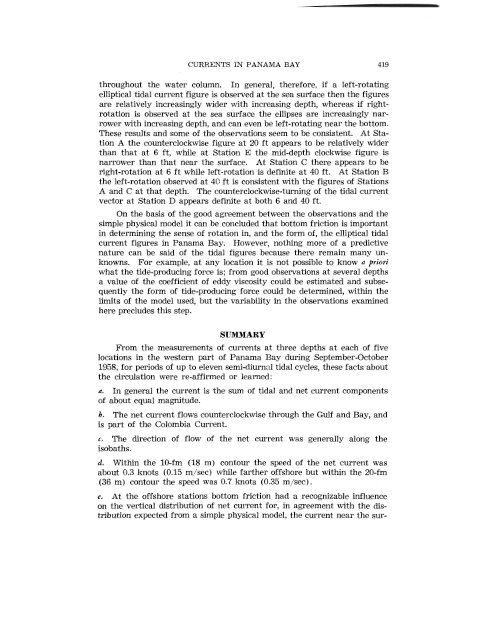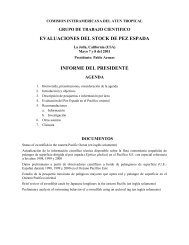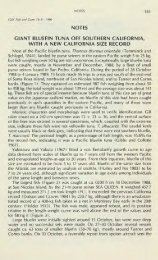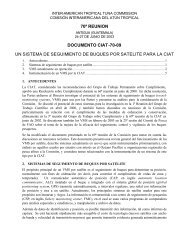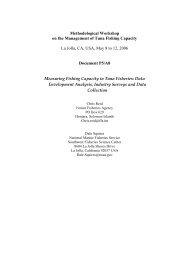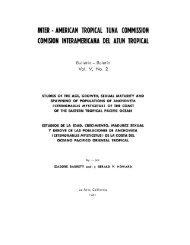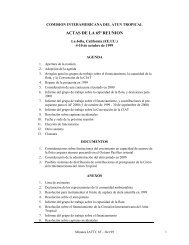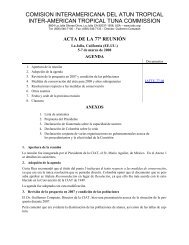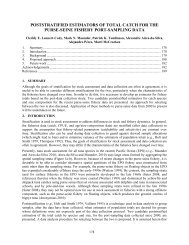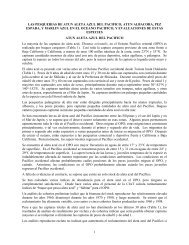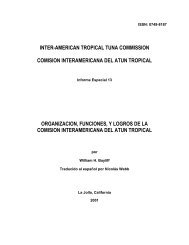t - Comisión Interamericana del Atún Tropical
t - Comisión Interamericana del Atún Tropical
t - Comisión Interamericana del Atún Tropical
- No tags were found...
You also want an ePaper? Increase the reach of your titles
YUMPU automatically turns print PDFs into web optimized ePapers that Google loves.
CURRENTS IN PANAMA BAY419throughout the water column. In general, therefore, if a left-rotatingelliptical tidal current figure is observed at the sea surface then the figuresare relatively increasingly wider with increasing depth, whereas if rightrotationis observed at the sea surface the ellipses are increasingly narrowerwith increasing depth, and can even be left-rotating near the bottom.These results and some of the observations seem to be consistent. At StationA the counterc1ockwise figure at 20 ft appears to be relatively widerthan that at 6 ft, while at Station E the mid-depth c10ckwise figure isnarrower than that near the surface. At Station C there appears to beright-rotation at 6 ft while left-rotation is definite at 40 ft. At Station Bthe left-rotation observed at 40 ft is consistent with the figures of StationsA and C at that depth. The counterc1ockwise-turning of the tidal currentvector at Station D appears definite at both 6 and 40 ft.On the basis of the good agreement between the observations and thesimple physical mo<strong>del</strong> it can be conc1uded that bottom friction is importantin determining the sense of rotation in, and the form of, the elliptical tidalcurrent figures in Panama Bay. However, nothing more of a predictivenature can be said of the tidal figures because there remain many unknowns.For example, at any location it is not possible to know a prioriwhat the tide-producing force is; from good observations at several depthsa value of the coefficient of eddy viscosity could be estimated and subsequentlythe form of tide-producing force could be determined, within thelimits of the mo<strong>del</strong> used, but the variability in the observations examinedhere prec1udes this step.SUMMARYFrom the measurements of currents at three depths at each of fivelocations in the western part of Panama Bay during September-October1958, for periods of up to eleven semi-diurnal tidal cyc1es, these facts aboutthe circulation were re-affirmed or learned:a. In general the current is the sum of tidal and net current componentsof about equal magnitude.b. The net current flows counterc1ockwise through the Gulf and Bay, andis part of the Colombia Current.c. The direction of flow of the net current was generally along theisobaths.d. Within the 10-fm (18 m) contour the speed of the net current wasabout 0.3 knots (0.15 m/sec) while farther offshore but within the 20-fm(36 m) contour the speed was 0.7 knots (0.35 m/sec).e. At the offshore stations bottom friction had a recognizable influenceon the vertical distribution of net current for, in agreement with the distributionexpected from a simple physical mo<strong>del</strong>, the current near the sur


